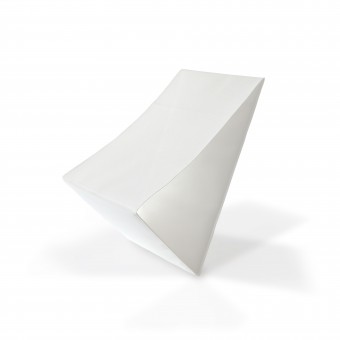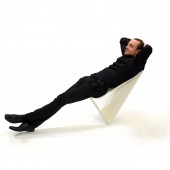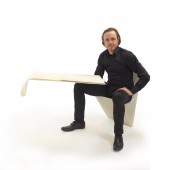Check Folding Chair by Thomas Rauscher |
Home > Winners > #55040 |
 |
|
||||
| DESIGN DETAILS | |||||
| DESIGN NAME: Check PRIMARY FUNCTION: Folding Chair INSPIRATION: We do not tilt on our chairs! Who does not remember this phrase from our past in school? Tilting on chairs means using only two of its legs. The missing ones are replaced by the legs of the person sitting on it. By doing so sitting transforms from a static to an actively balancing position. UNIQUE PROPERTIES / PROJECT DESCRIPTION: The chair is reduced to a minimum, aesthetically and constructional. In a nutshell, it is a self-supporting hammock, that uses the person sitting on it as a construction element. Due to its construction it only provides one skid underneath the person sitting on it, hence he or she has to balance, the sitting position becomes an active one. Additionally, the chair adapts due to its overall flexibility to any position. If not needed it can be collapsed to a thickness of 15 mm.. OPERATION / FLOW / INTERACTION: The person sittting on the chair becomes an active part of its construction by the use of his / her legs for a stable stand and to stiffen the seat by his / her back. By doing so its parts and its construction can be reduced to a minimum, consisting only of two thin panels granting stiffness where needed and a band of fabric connecting them and forming the flexible seat. The chair grants a maximum of flexibility sitting on it - it adopts to any position of the person sitting on it. It transforms sitting from a static position on common chairs to an active one. PROJECT DURATION AND LOCATION: The first ideas of using tilting on chairs as a design principle came up in 2011. Those early chairs where stiff, merely only chairs with only two legs with a modified position underneath the seat to grant a comfortable sitting position. In 2015 the idea was transformed to the current one, consisting only of two panels and a belt of fabric on the outside. The final idea of adding two pockets on the inside of the belt to slide the panels in came up by the end of 2015. FITS BEST INTO CATEGORY: Furniture Design |
PRODUCTION / REALIZATION TECHNOLOGY: The folding chair consists of one piece of tear resitance fabric and two wood panels. Its production methods are cutting and stiching the fabric, and cutting and milling the wood panels. Its assembly is being done by sliding the panels into the inside pockets of the fabric belt. The material used for the belt is a tear-resistant fabric, like canvas, batyline, tarp, carpet, and so on. The panels are made of plywood, cdf, reinforced plastic, and so on. SPECIFICATIONS / TECHNICAL PROPERTIES: being used: 400 x 390 x 690 mm, collapsed: 900 x 390 x 15 mm TAGS: chair, folding chair, minimal design, innovation, reduction, hammock chair RESEARCH ABSTRACT: The resarch can best be described as awareness. At some point I noticed that I tend to tilt on my stool most of the time. This was the initial spark of designing a chair based on tilting, by reducing the amount of its necessary legs to two, hence the person sitting on it has to balance all the time. The folding chair is a consquential step of the design process, by reducing stiffness to a minimum and granting flexibility to a maximum. Hence the design adapts to the user, not vice versa. CHALLENGE: We all have an perspective on how chairs have to work. When designing this chair I was confronted with three counter-arguments. Firstly - a chair which you can fall of easier than of common chair - this does not work! Secondly - this chair does not stand by itself - it cannot be noticed as a chair. It definitely needs a support to enable it standing by itself I was told. Thirdly - when using this chair the first time it might be a bit complicated to sit onto it and get off. Noone wants such a chair! ADDED DATE: 2017-02-25 18:32:35 TEAM MEMBERS (1) : IMAGE CREDITS: Thomas Rauscher, 2016. |
||||
| Visit the following page to learn more: http://www.bysomeone.com/en | |||||
| AWARD DETAILS | |
 |
Check Folding Chair by Thomas Rauscher is Winner in Furniture Design Category, 2016 - 2017.· Read the interview with designer Thomas Rauscher for design Check here.· Press Members: Login or Register to request an exclusive interview with Thomas Rauscher. · Click here to register inorder to view the profile and other works by Thomas Rauscher. |
| SOCIAL |
| + Add to Likes / Favorites | Send to My Email | Comment | Testimonials | View Press-Release | Press Kit |
Did you like Thomas Rauscher's Furniture Design?
You will most likely enjoy other award winning furniture design as well.
Click here to view more Award Winning Furniture Design.








